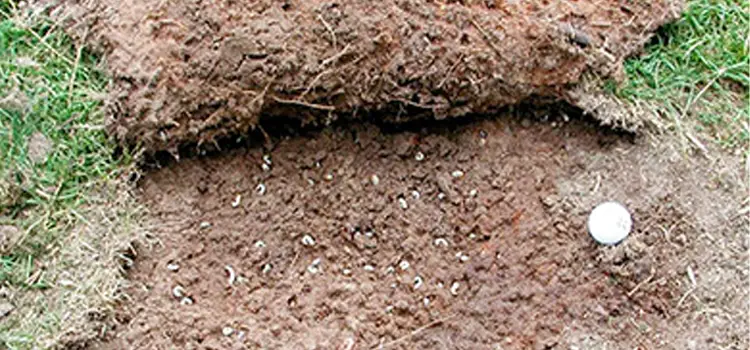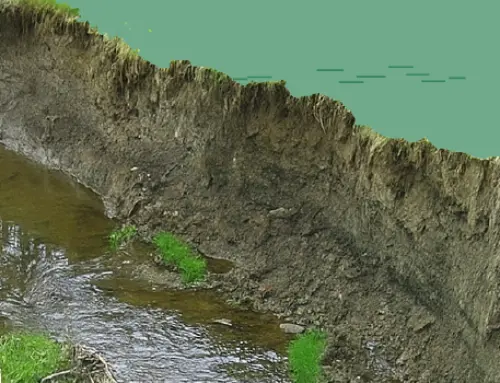How to Identify Different Grubs in Pennsylvania
by Jenna Mendez
10 min read
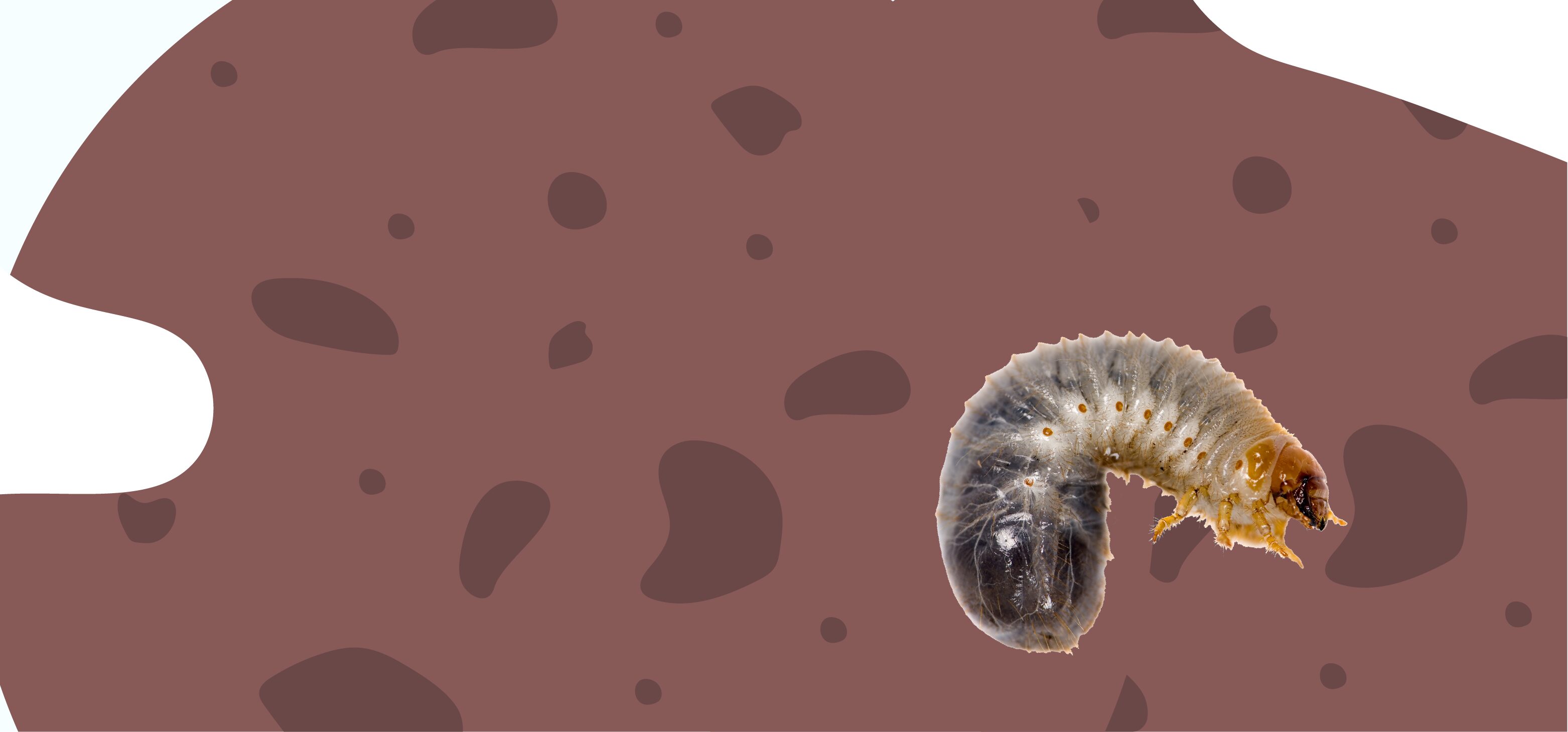
Imagine your lawn as the neighborhood’s finest buffet—lush, green, and perfectly trimmed, a place where all the other lawns are just a little bit jealous. But while you’re admiring your hard work, there’s a secret party happening underground, and the VIP guests are none other than those pesky grubs.
To them, your well-manicured lawn is like an all-you-can-eat salad bar. These annoying pests are no help to maintaining the perfect PA lawn. If you’re experiencing this problem, we’ve got your guide on how to identify different types of grubs in Pennsylvania. We’ll explore how to identify, get rid of, and ward off these pests to keep your lawn looking spiffy.
What are grubs?
“What are grubs?” is a question that many lawn enthusiasts ask. Grubs are the larval stage of various beetles, including Japanese beetle grubs and other species that are most commonly found in PA lawns and gardens. Most pests are dirty white, soft-bodied, and robust with a brown head and legs.
Commonly found in a “C” shape, these larvae are found in the soil, where they feed on the roots of grass and plants, causing damage to lawns and gardens.
Identifying grubs in your lawn
To protect your lawn, the first step is identifying garden grubs. Grubs are generally white with C-shaped bodies. Here’s how to identify grubs in your lawn:
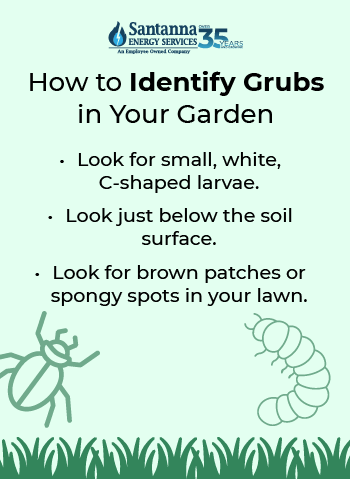
- Look for small, white, C-shaped larvae.
- Look just below the soil surface.
- Look for brown patches or spongy spots in your lawn. If you see these frequently in your landscaping, this can be a sign of an infestation.
- Conduct the pull test: Pull a clump of grass; if your grass is still connected to the soil, your landscaping is healthy. If your grass comes out easily, this is a good sign your lawn has grubs.
- Conduct the shovel test: Start by digging out a small 6-8 inch plug near a suspected damaged area; make sure you can see the roots. Examine the roots on your plug and if they look withered and dead, this is a positive sign of an infestation. Similarly, grubs can bury themselves far into the soil. If you dig down deep enough, you should be able to unearth some larvae to confirm they’re the cause of the problem.
Some of the most common grubs you can find in a PA garden are Japanese Beetles, Masked Chafer Beetles, and Scarab Beetles.
Japanese Beetle grubs
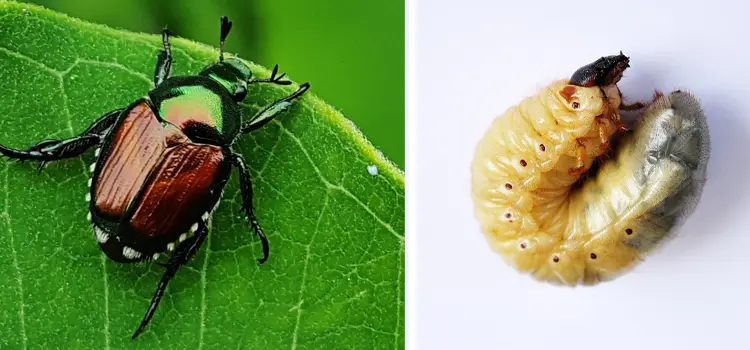
Japanese beetle grubs are among the most notorious lawn pests, especially in Pennsylvania. Their presence in the larval stage is a clear sign that your lawn is under attack. Do Japanese beetles bite? No, but their larvae can cause significant damage to your lawn.
How to identify Japanese Beetles
What do they look like? Japanese beetle grubs are C-shaped and have easy-to-identify tan-colored skin. They have fully developed legs that are easy to see and can grow up to one inch long. One defining factor of a Japanese beetle grub is its spine patterns that form a “V” shape and its hairs on its underside.
Signs of damage: Japanese beetle grubs love to chew grass roots which reduces your lawns ability to maintain water and nutrients. When this happens you’ll see dry, brown patches of grass.
Commonly found: Adult Japanese beetles love to feed on flowers, trees, fruits, and vegetables. They mainly hang out on the leaves and prefer plants like roses, grapes, apples, Burch trees, and Marigolds. Japanese beetle larvae mostly feed on the roots of grass.
Masked Chafer Beetle grubs
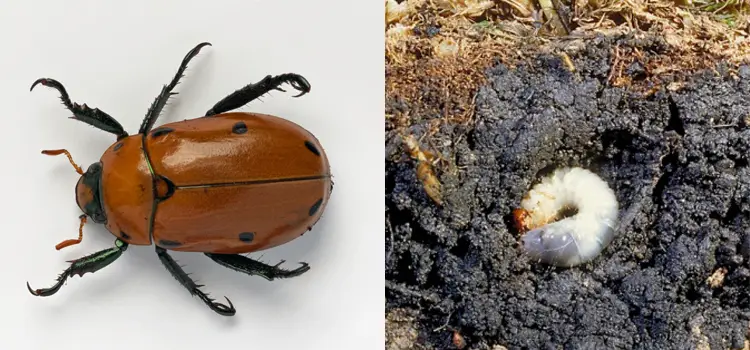
Masked Chafer Beetles are another common culprit behind grub infestations in Pennsylvania lawns. Their larvae are similar in appearance to those of the Japanese beetle but tend to be slightly larger and less segmented.
How to identify Masked Chafer Beetle grubs
What do they look like? These grubs are usually white, with a distinctive C-shape, and can be found just beneath the soil surface, feeding on grassroots. They are known for causing significant damage, especially in late summer when they are most active.
Signs of damage: Like other grubs, they feed on grassroots, leading to brown patches and a weakened lawn structure.
Commonly found: Masked Chafer Beetle grubs are commonly found in lawns and turfgrass. They are prevalent in well-maintained lawns, golf courses, and sports fields where moisture is abundant.
Scarab Beetle grubs
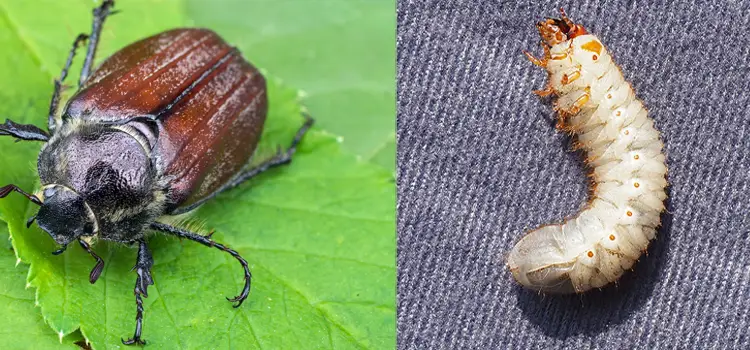
Scarab Beetles, which include various species like the June beetle, also have larvae that are known as grubs. These grubs are a bit larger than others and are notorious for causing damage to both lawns and garden plants.
How to identify Scarab Beetle grubs
What do they look like? Scarab Beetle grubs are larger and have a similar C-shaped body, but they are more robust, with a slightly darker head. They can be found deeper in the soil compared to other grubs.
Signs of damage: These grubs can cause severe damage to the lawn and garden, feeding on roots and disrupting the soil structure, which can lead to patches of dead grass and wilting plants.
Commonly found: Scarab Beetle grubs are commonly found in soil, where they feed on the roots of grasses, plants, and decaying organic matter. In Pennsylvania, they are often found in areas with rich, moist soil.
Signs of grub infestation
Knowing what does grub-infested grass looks like is crucial for early detection. Common signs of grubs in grass include:
- Irregular Brown Patches: One of the most common damage signs of grubs on lawn is the appearance of brown, dead patches of grass that don’t green up with watering.
- Increased Animal Activity: If you notice an unusual number of birds, skunks, raccoons, or moles digging up your lawn, they might be after the grubs beneath the surface.
- Loose or Easily Pulled-Up Grass: Grass that pulls up easily, almost like a loose carpet, is a strong indicator of grub damage.
- Wilting Grass: Even with adequate water, grass that wilts or appears stressed can be a sign that the roots have been compromised by grubs.
What does grub-infested grass look like?
Grub damage typically shows itself in mid-September to November or early parts of March to May. Patches of lawns turn yellow or brown and feel spongy beneath your feet. Grub-infested grass often looks patchy and wilted, and some grass patches can be pulled upwards like a loose carpet.
How to check your lawn
To check your lawn, use a spade to lift a 12-inch-square piece of sod about 3 inches thick. Inspect the soil and roots closely. Healthy lawns can tolerate a few grubs, but ten or more per square foot indicates serious problems.
Sometimes, even getting to ground level can help determine if your lawn is under infestation. If you see grubs within your grass or buried in your soil, you have an infestation on your hands.
How to get rid of grubs
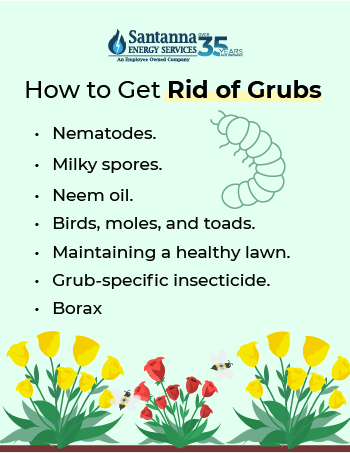
When dealing with grubs in any part of your landscaping, it’s essential to act quickly to prevent widespread damage. Proper mowing and watering is one of the easiest ways to keep grubs away. Here are some of the more technical ways to get rid of grubs in certain sections of your garden:
How to get rid of grubs in your lawn
- The most effective way to eliminate grubs from your lawn is to apply a grub-specific insecticide during early fall or early spring when the grubs are young and close to the soil surface.
- Consider using nematodes or milky spore disease, which are natural enemies of grubs and can help reduce their numbers without the use of chemicals.
- Regular lawn maintenance, such as fertilizing and mowing, can also reduce the likelihood of grub infestation.
How to get rid of grubs in your vegetable garden
- Use natural remedies like beneficial nematodes to target grubs without harming your plants. These treatments are effective and environmentally friendly.
- You may also consider neem oil, which disrupts the grubs’ development and prevents further damage.
- Spraying light amounts of borax with warm water can detour these bugs too. This can cause damage to plants and grass if sprayed too often.
How to get rid of grubs naturally
- Beneficial nematodes are microscopic worms that actively seek out and kill grubs in the soil. They are a natural predator of grubs and can be applied to affected areas of your lawn, garden, or vegetable garden.
- Nematodes are harmless to humans, pets, and beneficial insects, making them a safe and effective option for natural grub control.
- Milky spores are naturally occurring bacteria that specifically target the larvae of Japanese beetles, one of the most common grub species in PA. Once applied, milky spore can remain in the soil for years, providing long-term protection against grubs.
- Neem oil is a natural insecticide derived from the seeds of the neem tree. It works by disrupting the growth and development of grubs, eventually leading to their death.
- Encouraging natural predators such as birds, moles, and toads can help control grub populations. Leaving out food for these animals can help draw them to your lawn.
- Maintaining a healthy lawn through proper watering, mowing, and fertilizing can make your lawn less susceptible to grub infestations.
How to get rid of Japanese Beetle grubs
Using milky spores is one of the best ways to detour Japanese Beetle grubs. Milky spores can be ingested by Japanese Beetle grubs leading to their death in less than 3 weeks.
Other methods like lawn care, neem oil, and natural household mixtures are effective ways of grub control too.
When to apply grub control
When should you apply grub control and when should you treat for grubs? Timing is crucial for effective grub control. Treatments are most effective when applied when grubs are actively feeding near the surface.
Preventive treatments, applied in the spring or early summer before the eggs hatch, can help reduce future infestations by targeting young grubs before they cause significant damage.
Impact of grubs on your Pennsylvania garden as a whole
On lawns, grubs feed on grassroots, weakening your lawn and making it susceptible to other problems. If left untreated, the damage can be extensive, requiring significant lawn repair efforts.
Grubs don’t just affect lawns; they can also target other plants in the garden. While grass is their primary target, they sometimes feed on the roots of other plants, leading to broader garden issues.
A grub infestation can lead to poor soil health, affecting the lawn’s ability to recover even after the grubs are gone. Grubs disrupt soil structure, which can lead to erosion or poor water retention.
When to call a professional grub control team
Severe Grub Infestation: If you notice widespread patches of dead grass or if your lawn feels spongy when you walk on it, the grub population might be out of control.
Recurring Grub Problems: If grubs keep coming back despite your best efforts, there might be underlying issues that only a professional can diagnose and treat.
Lack of Time or Expertise: Grub control requires proper timing, knowledge of treatments, and consistent follow-up.
While grubs can be a nuisance, understanding how to identify and control them is key to maintaining a healthy lawn in Pennsylvania. Whether dealing with Japanese Beetles, Masked Chafer Beetles, or Scarab Beetles, monitoring can go a long way in preventing severe damage. By protecting your lawn from grubs, you’re not only enhancing your property but also contributing to a healthier environment for your community.
Santanna Energy Services is a supplier of earth-friendly natural gas and electricity solutions for your home. For over 35 years, Santanna has served customers in Illinois, Indiana, Pennsylvania, Michigan, and Ohio. Our mission is to provide innovative and cost-effective energy solutions that will help our customers achieve their energy goals.
Jenna Mendez is a Midwest native with lifelong roots in Illinois and time spent in Ohio during college, giving her a deep understanding of the Midwest region’s people, climate, and energy needs. She brings firsthand experience and local insight to topics that matter to Midwest homeowners, especially energy efficiency, sustainability, and home living. Jenna specializes in writing about eco-friendly living, all things Midwest, renewable energy, and practical ways to reduce energy costs. Jenna brings a trusted, and local hometown voice to every article she writes, helping readers live well, and sustainably, right where they are.


